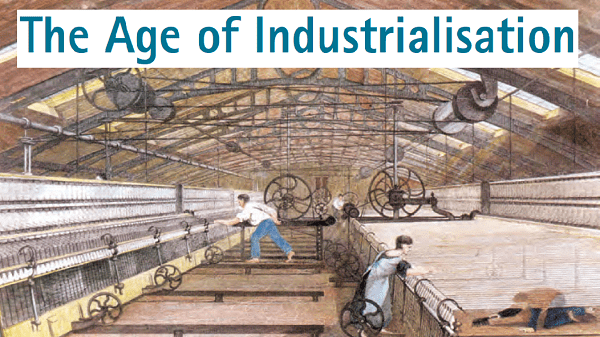Class 10 History Chapter 4 Question Answers - The Age of Industrialisation

Q1. What factors were responsible for increasing demand for goods? Give an example.
Ans.
- Expansion of trade and acquisition of colonies in the seventeenth and eighteenth centuries led to the increasing demand for goods.
- For example, acquisition of colonies was an important activity undertaken by Europeans in the eighteenth and nineteenth centuries.
- When colonies were established, they had more resources and markets for their products. As a result, the volume of trade increased.
Q2. What were the first symbols of industrialisation?
Ans.
- Cotton and metal (iron and steel) production were the first symbols of industrialisation.
- Factories in England emerged as early as the 1730s and their number increased steadily.
- Changes in the production process included carding, twisting, spinning, and rolling.
Q3. Write a short note on trade guilds.
Ans. Trade guilds were associations of producers that trained craft persons and artists. They exercised control over production through regulated competition and prices. They also restricted the entry of new people into the trade. Most of them were granted the right to produce specific products by their rulers.
Q4. What other sectors of production benefited from ordinary inventions?
Ans.
- Cotton and metal were steam-powered industries.
- Some small and ordinary inventions contributed in many non-mechanised sectors.
- These sectors include food processing, building, pottery, glasswork, tanning, furniture-making, and production of implements.
Q5. What is the most recent views regarding industrial revolution of the eighteenth and mid-nineteenth centuries?
Ans.
- Modern historians have now recognised the important role of the traditional craftspersons and labourers of the mid-nineteenth century in recent years.
- Technological changes were slow and expensive, and were not as effective as claimed because merchants and manufacturers were cautious in using them for their cost and maintenance.
Q6. Write a short note on the condition of a labour’s life in Victorian Britain.
Ans. Victorian Britain was a period marked by a high availability of labour. Poor peasants and vagrants migrated to the cities in large numbers in search of work. The influx of workers resulted in low wages, who were exploited by the producers.
Q7. Explain why machines did not necessarily affect the employment of labours.
Ans.
- Machines required large capital investments.
- The introduction of machines did not necessarily affect the traditional process of production for a long time.
- The need for machines varied according to available labour.
- Where there was plenty of labour, wages were low.
Q8. What were the limits of machine-made products?
Ans.
- Machines were limited by their inability to produce a variety of products.
- Machines produced only uniform, standardized products meant for mass markets.
- However, demands in European markets were mainly for intricate and specific designs.
Q9. Who invented the Spinning Jenny? How did it work?
Ans.
- The spinning jenny was devised by James Hargreaves in 1764.
- It speeded up the spinning process and reduced the labour demand.
- One single turning of the wheel could set in motion a number of spindles and spin several threads of yarn.
Q10. What is the monopoly of trade?
Ans.
- Monopoly of trade is the practice in which a country develops a system of management and control.
- This practice eliminates competition in the market.
- It allows countries to control costs effectively and ensures a regulated supply of products.
- For example, British colonisers used to monopolise products such as silk and cotton in India.
Q11. How did the Indian weavers react to the monopoly of cotton production?
Ans.
- Indian weavers reacted strongly to the monopoly of cotton production.
- They became increasingly reliant on income from raw cotton sales, which diminished their independence and bargaining power.
- As a result, many weavers in Carnatic and Bengal deserted their villages and migrated. Some also joined traders in revolting against officials.
Q12. Discuss the impact of the Indian national movement on Indian entrepreneurs.
Ans.
- During the period of the Indian national movement in the early twentieth century, Swadeshi activists boycotted and burned foreign goods.
- Indigenous industrialists organised themselves to demand tariff protection and grants from the Government, which led to the establishment of certain regulations.
- Indian industries benefited, especially during the wartime, as it was able to diversify the products into war goods, steel and iron, etc.
|
63 videos|445 docs|87 tests
|
FAQs on Class 10 History Chapter 4 Question Answers - The Age of Industrialisation
| 1. What is the age of industrialization? |  |
| 2. What were the major effects of industrialization? |  |
| 3. What was the impact of industrialization on agriculture? |  |
| 4. How did industrialization impact the global economy? |  |
| 5. What were the major inventions of the Industrial Revolution? |  |

|
Explore Courses for Class 10 exam
|

|


















